2015 DODGE CHALLENGER overheating
[x] Cancel search: overheatingPage 206 of 603
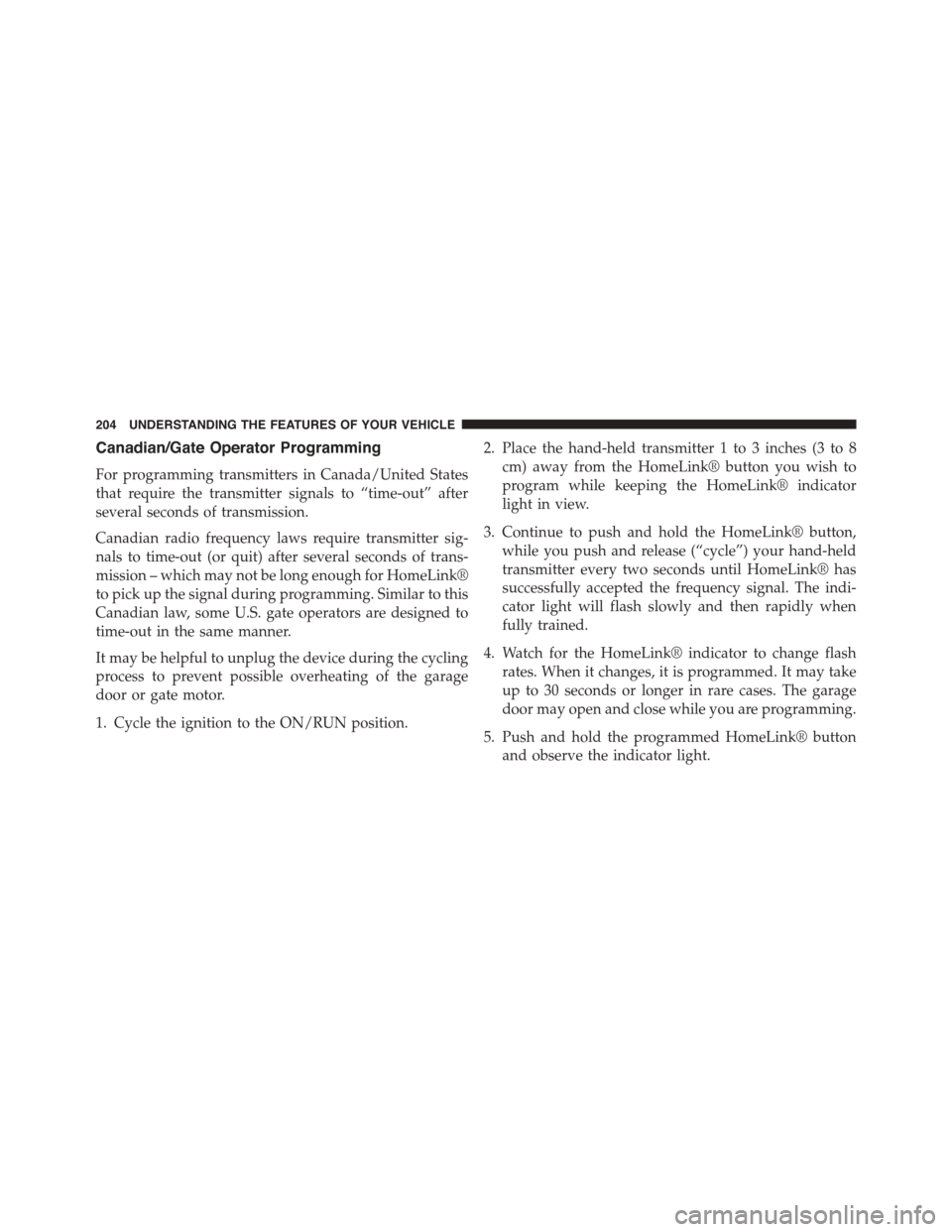
Canadian/Gate Operator Programming
For programming transmitters in Canada/United States
that require the transmitter signals to “time-out” after
several seconds of transmission.
Canadian radio frequency laws require transmitter sig-
nals to time-out (or quit) after several seconds of trans-
mission – which may not be long enough for HomeLink®
to pick up the signal during programming. Similar to this
Canadian law, some U.S. gate operators are designed to
time-out in the same manner.
It may be helpful to unplug the device during the cycling
process to prevent possible overheating of the garage
door or gate motor.
1. Cycle the ignition to the ON/RUN position.
2. Place the hand-held transmitter 1 to 3 inches (3 to 8
cm) away from the HomeLink® button you wish to
program while keeping the HomeLink® indicator
light in view.
3. Continue to push and hold the HomeLink® button,
while you push and release (“cycle”) your hand-held
transmitter every two seconds until HomeLink® has
successfully accepted the frequency signal. The indi-
cator light will flash slowly and then rapidly when
fully trained.
4. Watch for the HomeLink® indicator to change flash
rates. When it changes, it is programmed. It may take
up to 30 seconds or longer in rare cases. The garage
door may open and close while you are programming.
5. Push and hold the programmed HomeLink® button
and observe the indicator light.
204 UNDERSTANDING THE FEATURES OF YOUR VEHICLE
Page 326 of 603
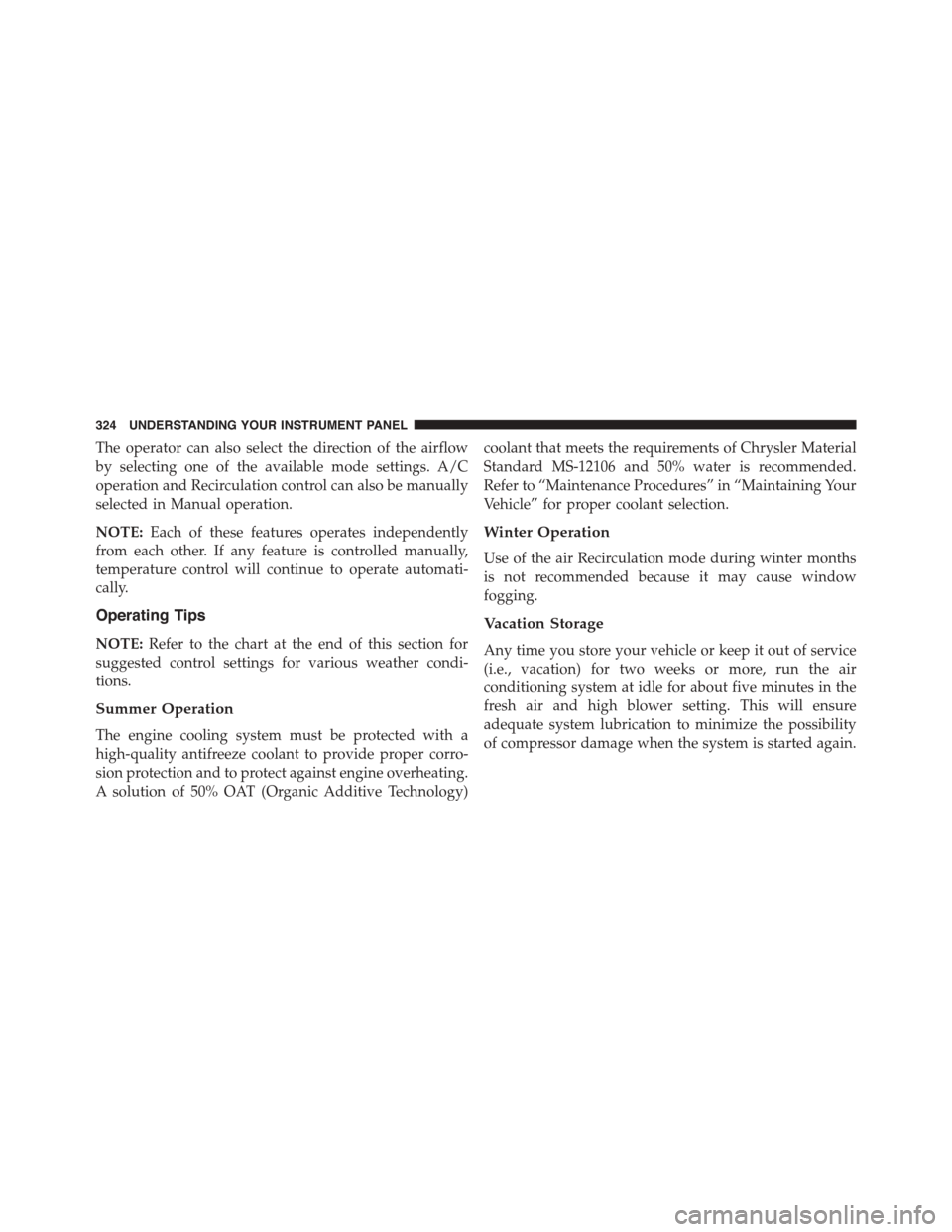
The operator can also select the direction of the airflow
by selecting one of the available mode settings. A/C
operation and Recirculation control can also be manually
selected in Manual operation.
NOTE:Each of these features operates independently
from each other. If any feature is controlled manually,
temperature control will continue to operate automati-
cally.
Operating Tips
NOTE:Refer to the chart at the end of this section for
suggested control settings for various weather condi-
tions.
Summer Operation
The engine cooling system must be protected with a
high-quality antifreeze coolant to provide proper corro-
sion protection and to protect against engine overheating.
A solution of 50% OAT (Organic Additive Technology)
coolant that meets the requirements of Chrysler Material
Standard MS-12106 and 50% water is recommended.
Refer to “Maintenance Procedures” in “Maintaining Your
Vehicle” for proper coolant selection.
Winter Operation
Use of the air Recirculation mode during winter months
is not recommended because it may cause window
fogging.
Vacation Storage
Any time you store your vehicle or keep it out of service
(i.e., vacation) for two weeks or more, run the air
conditioning system at idle for about five minutes in the
fresh air and high blower setting. This will ensure
adequate system lubrication to minimize the possibility
of compressor damage when the system is started again.
324 UNDERSTANDING YOUR INSTRUMENT PANEL
Page 455 of 603
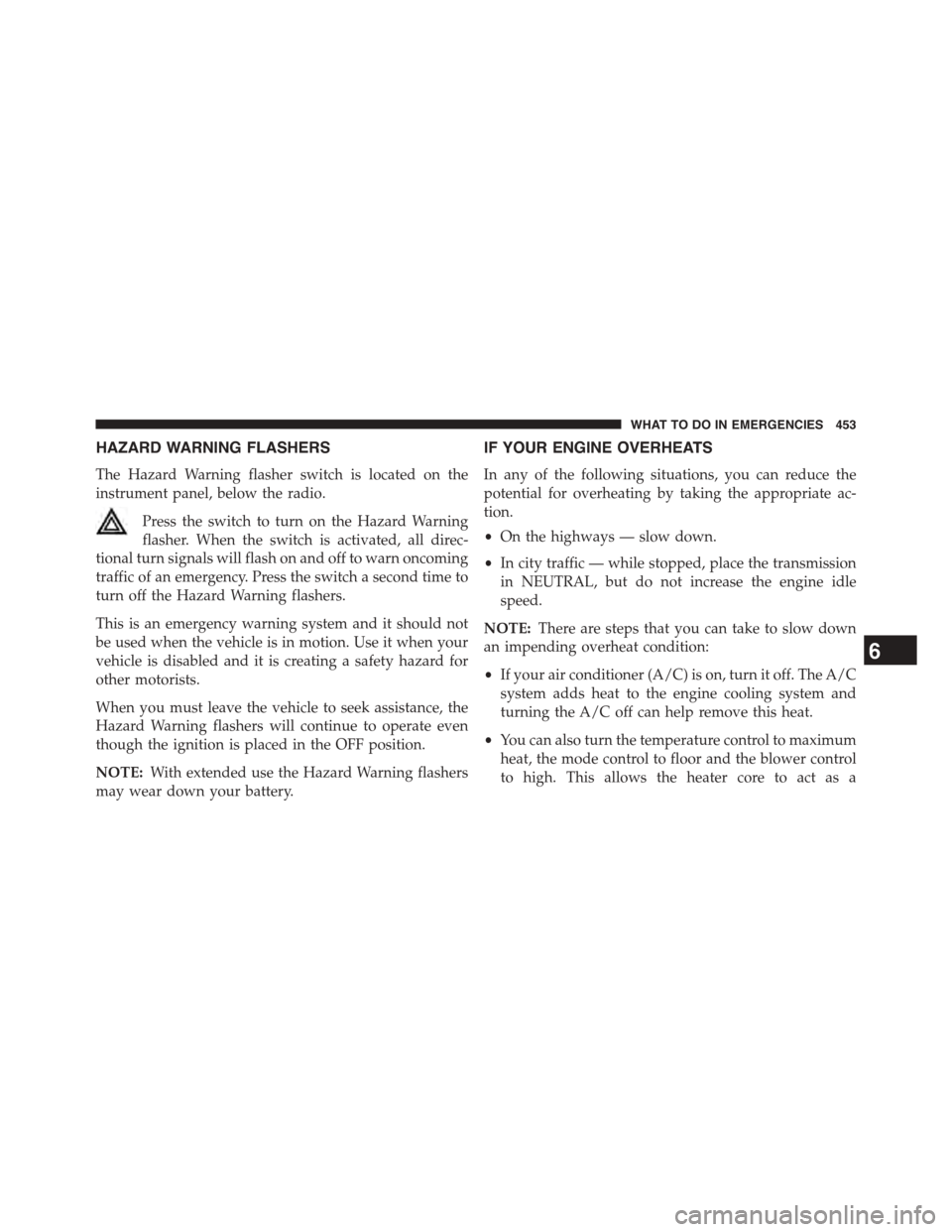
HAZARD WARNING FLASHERS
The Hazard Warning flasher switch is located on the
instrument panel, below the radio.
Press the switch to turn on the Hazard Warning
flasher. When the switch is activated, all direc-
tional turn signals will flash on and off to warn oncoming
traffic of an emergency. Press the switch a second time to
turn off the Hazard Warning flashers.
This is an emergency warning system and it should not
be used when the vehicle is in motion. Use it when your
vehicle is disabled and it is creating a safety hazard for
other motorists.
When you must leave the vehicle to seek assistance, the
Hazard Warning flashers will continue to operate even
though the ignition is placed in the OFF position.
NOTE:With extended use the Hazard Warning flashers
may wear down your battery.
IF YOUR ENGINE OVERHEATS
In any of the following situations, you can reduce the
potential for overheating by taking the appropriate ac-
tion.
•On the highways — slow down.
•In city traffic — while stopped, place the transmission
in NEUTRAL, but do not increase the engine idle
speed.
NOTE:There are steps that you can take to slow down
an impending overheat condition:
•If your air conditioner (A/C) is on, turn it off. The A/C
system adds heat to the engine cooling system and
turning the A/C off can help remove this heat.
•You can also turn the temperature control to maximum
heat, the mode control to floor and the blower control
to high. This allows the heater core to act as a
6
WHAT TO DO IN EMERGENCIES 453
Page 482 of 603
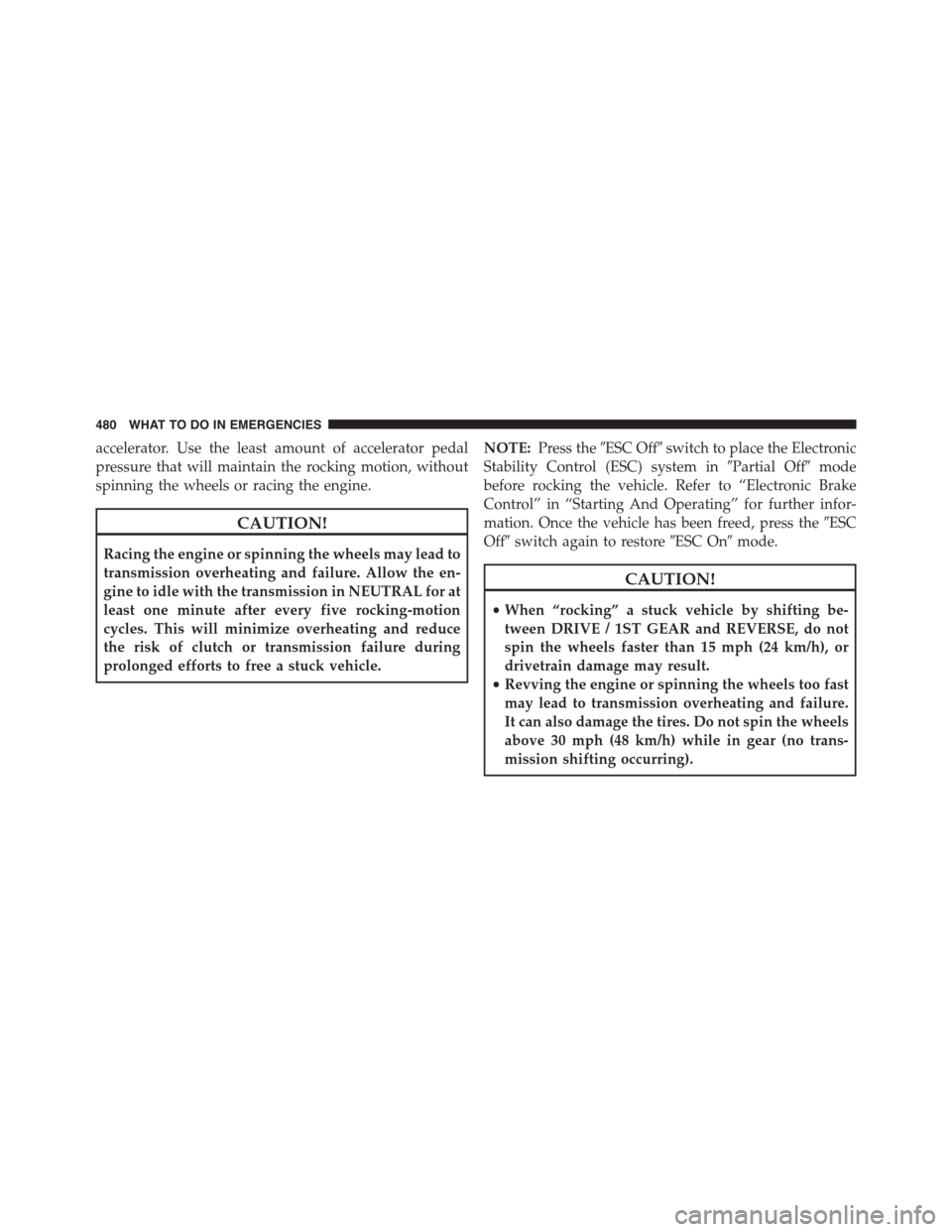
accelerator. Use the least amount of accelerator pedal
pressure that will maintain the rocking motion, without
spinning the wheels or racing the engine.
CAUTION!
Racing the engine or spinning the wheels may lead to
transmission overheating and failure. Allow the en-
gine to idle with the transmission in NEUTRAL for at
least one minute after every five rocking-motion
cycles. This will minimize overheating and reduce
the risk of clutch or transmission failure during
prolonged efforts to free a stuck vehicle.
NOTE:Press the#ESC Off#switch to place the Electronic
Stability Control (ESC) system in#Partial Off#mode
before rocking the vehicle. Refer to “Electronic Brake
Control” in “Starting And Operating” for further infor-
mation. Once the vehicle has been freed, press the#ESC
Off#switch again to restore#ESC On#mode.
CAUTION!
•When “rocking” a stuck vehicle by shifting be-
tween DRIVE / 1ST GEAR and REVERSE, do not
spin the wheels faster than 15 mph (24 km/h), or
drivetrain damage may result.
•Revving the engine or spinning the wheels too fast
may lead to transmission overheating and failure.
It can also damage the tires. Do not spin the wheels
above 30 mph (48 km/h) while in gear (no trans-
mission shifting occurring).
480 WHAT TO DO IN EMERGENCIES
Page 512 of 603
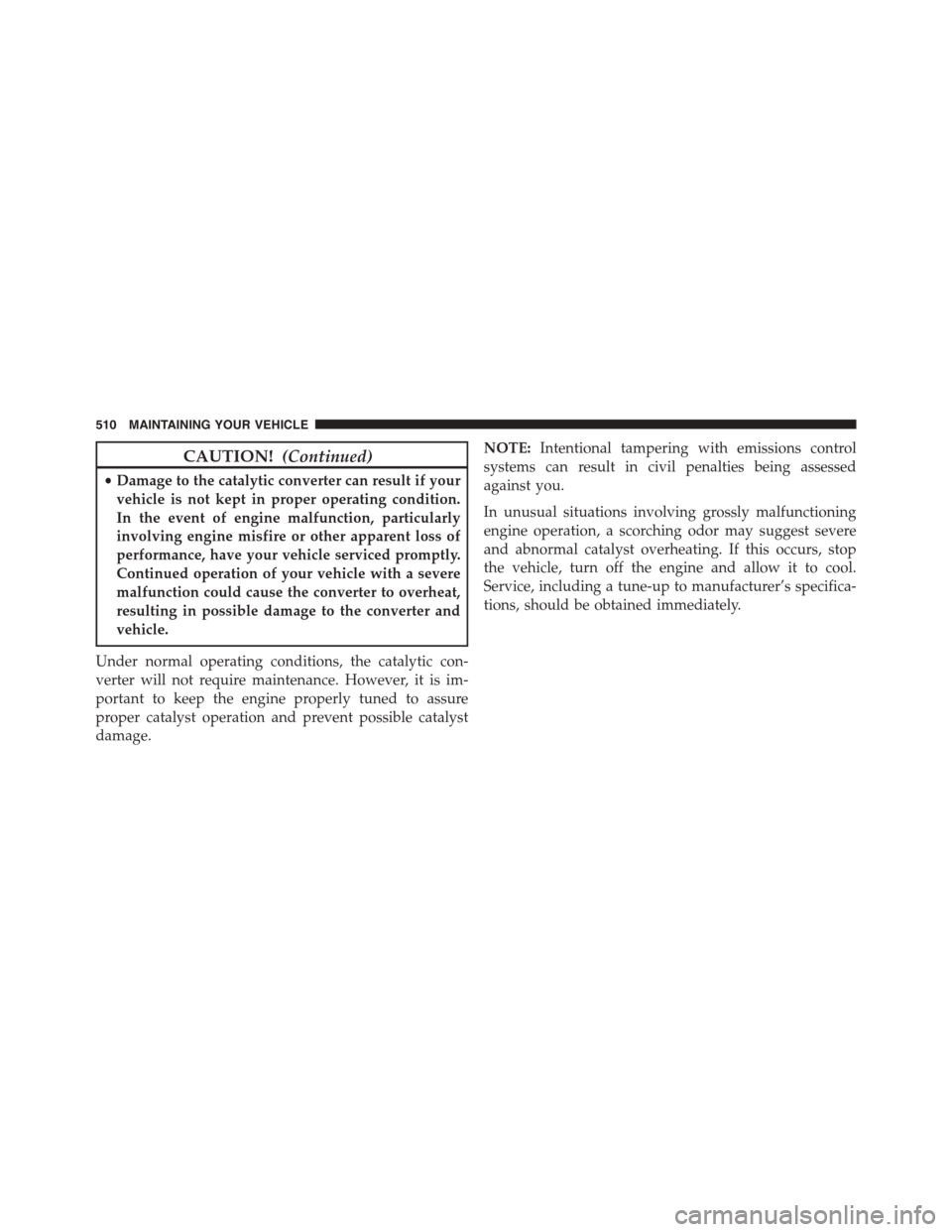
CAUTION!(Continued)
•Damage to the catalytic converter can result if your
vehicle is not kept in proper operating condition.
In the event of engine malfunction, particularly
involving engine misfire or other apparent loss of
performance, have your vehicle serviced promptly.
Continued operation of your vehicle with a severe
malfunction could cause the converter to overheat,
resulting in possible damage to the converter and
vehicle.
Under normal operating conditions, the catalytic con-
verter will not require maintenance. However, it is im-
portant to keep the engine properly tuned to assure
proper catalyst operation and prevent possible catalyst
damage.
NOTE:Intentional tampering with emissions control
systems can result in civil penalties being assessed
against you.
In unusual situations involving grossly malfunctioning
engine operation, a scorching odor may suggest severe
and abnormal catalyst overheating. If this occurs, stop
the vehicle, turn off the engine and allow it to cool.
Service, including a tune-up to manufacturer’s specifica-
tions, should be obtained immediately.
510 MAINTAINING YOUR VEHICLE
Page 586 of 603
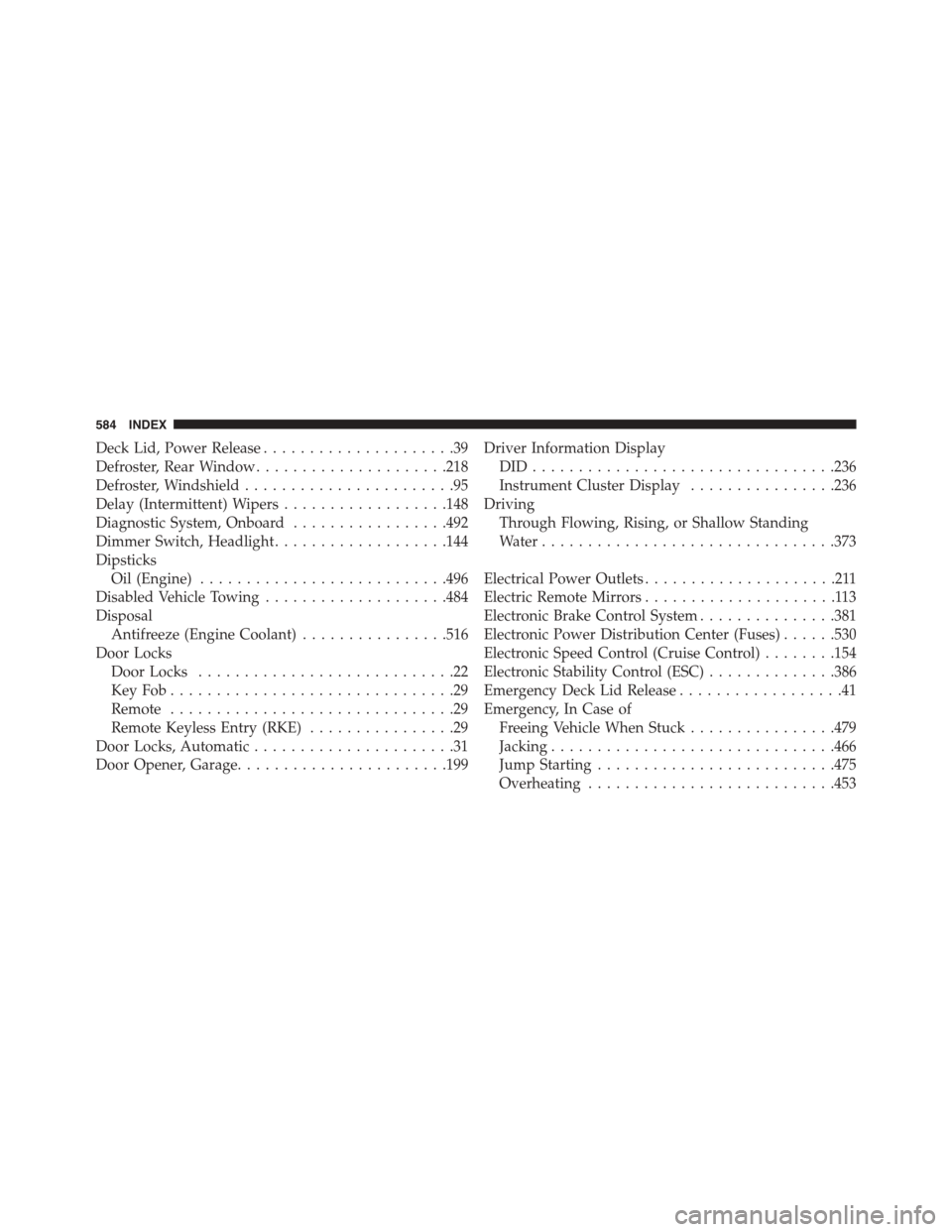
Deck Lid, Power Release.....................39
Defroster, Rear Window.....................218
Defroster, Windshield.......................95
Delay (Intermittent) Wipers..................148
Diagnostic System, Onboard.................492
Dimmer Switch, Headlight...................144
Dipsticks
Oil (Engine)...........................496
Disabled Vehicle Towing....................484
Disposal
Antifreeze (Engine Coolant)................516
Door Locks
Door Locks............................22
Key Fob . . . . . . . . . . . . . . . . . . . . . . . . . . . . . . .29
Remote...............................29
Remote Keyless Entry (RKE)................29
Door Locks, Automatic......................31
Door Opener, Garage.......................199
Driver Information Display
DID . . . . . . . . . . . . . . . . . . . . . . . . . . . . . . . ..236
Instrument Cluster Display................236
Driving
Through Flowing, Rising, or Shallow Standing
Water................................373
Electrical Power Outlets.....................211
Electric Remote Mirrors.....................113
Electronic Brake Control System...............381
Electronic Power Distribution Center (Fuses)......530
Electronic Speed Control (Cruise Control)........154
Electronic Stability Control (ESC)..............386
Emergency Deck Lid Release..................41
Emergency, In Case of
Freeing Vehicle When Stuck................479
Jacking...............................466
Jump Starting..........................475
Overheating...........................453
584 INDEX
Page 587 of 603

Towing..............................484
Emergency Trunk Release....................41
Emission Control System Maintenance..........493
Engine.................................490
Air Cleaner...........................501
Block Heater..........................354
Break-In Recommendations.................90
Checking Oil Level......................496
Compartment..........................489
Compartment Identification................489
Coolant (Antifreeze).....................512
Cooling..............................511
Exhaust Gas Caution.....................94
Fails to Start...........................352
Flooded, Starting.......................352
Fuel Requirements......................425
Jump Starting..........................475
Oil . . . . . . . . . . . . . . . . . . . . . . . . . . . . . . . . ..496
Oil Change Interval......................497
Oil Filler Cap..........................499
Oil Selection...........................498
Oil Synthetic..........................500
Overheating...........................453
Starting..............................347
Temperature Gauge......................229
Engine Oil Viscosity.......................499
Engine Oil Viscosity Chart...................499
Enhanced Accident Response Feature............64
Entry System, Illuminated....................20
Ethanol................................427
Event Data Recorder........................68
Exhaust Gas Caution........................94
Exhaust System...........................94
Exterior Folding Mirrors....................113
Exterior Lighting..........................138
Exterior Lights............................97
Filler Location Fuel........................43110
INDEX 585
Page 594 of 603
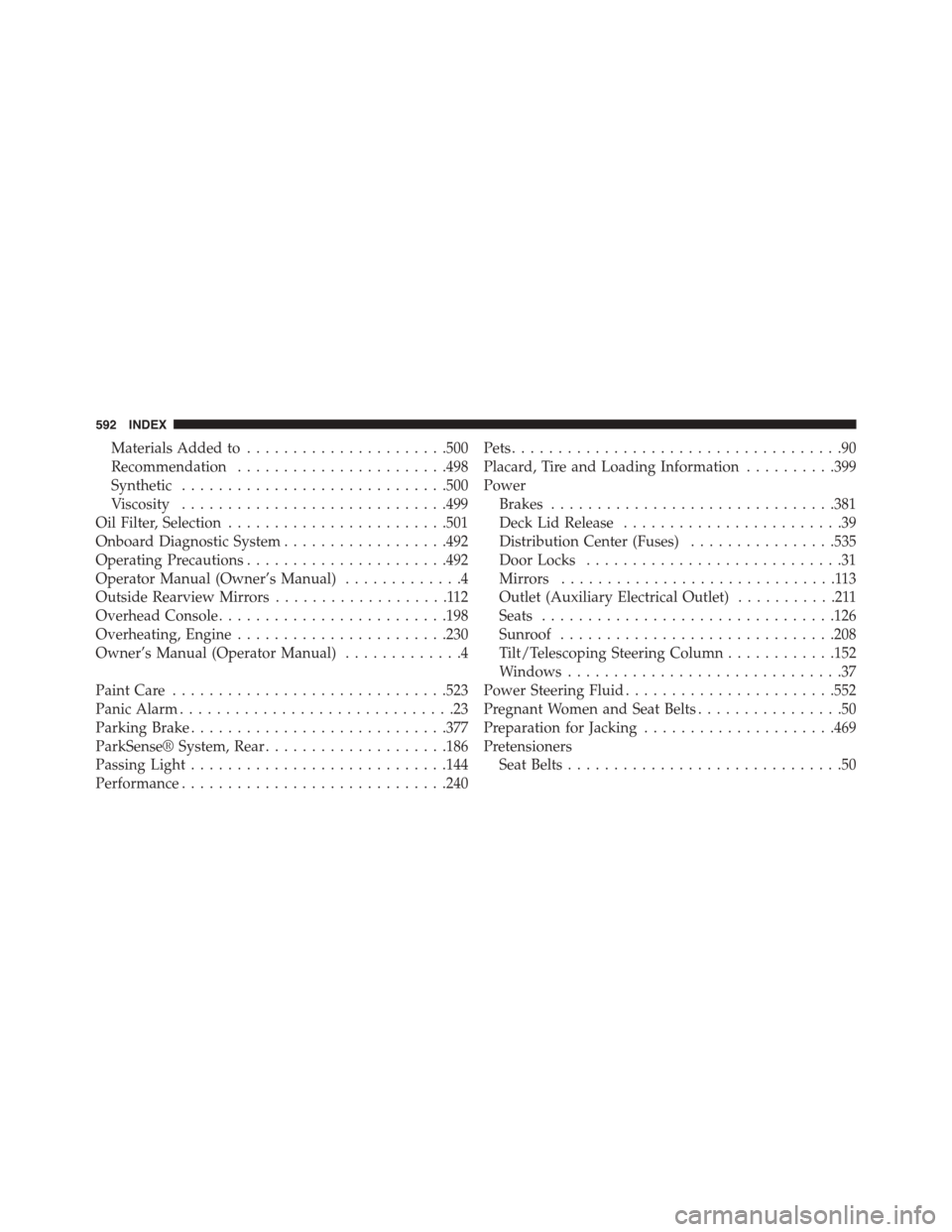
Materials Added to......................500
Recommendation.......................498
Synthetic.............................500
Viscosity.............................499
Oil Filter, Selection........................501
Onboard Diagnostic System..................492
Operating Precautions......................492
Operator Manual (Owner’s Manual).............4
Outside Rearview Mirrors...................112
Overhead Console.........................198
Overheating, Engine.......................230
Owner’s Manual (Operator Manual).............4
Paint Care..............................523
Panic Alarm..............................23
Parking Brake............................377
ParkSense® System, Rear....................186
Passing Light............................144
Performance.............................240
Pets....................................90
Placard, Tire and Loading Information..........399
Power
Brakes...............................381
Deck Lid Release........................39
Distribution Center (Fuses)................535
Door Locks............................31
Mirrors..............................113
Outlet (Auxiliary Electrical Outlet)...........211
Seats................................126
Sunroof..............................208
Tilt/Telescoping Steering Column............152
Windows..............................37
Power Steering Fluid.......................552
Pregnant Women and Seat Belts................50
Preparation for Jacking.....................469
Pretensioners
Seat Belts..............................50
592 INDEX